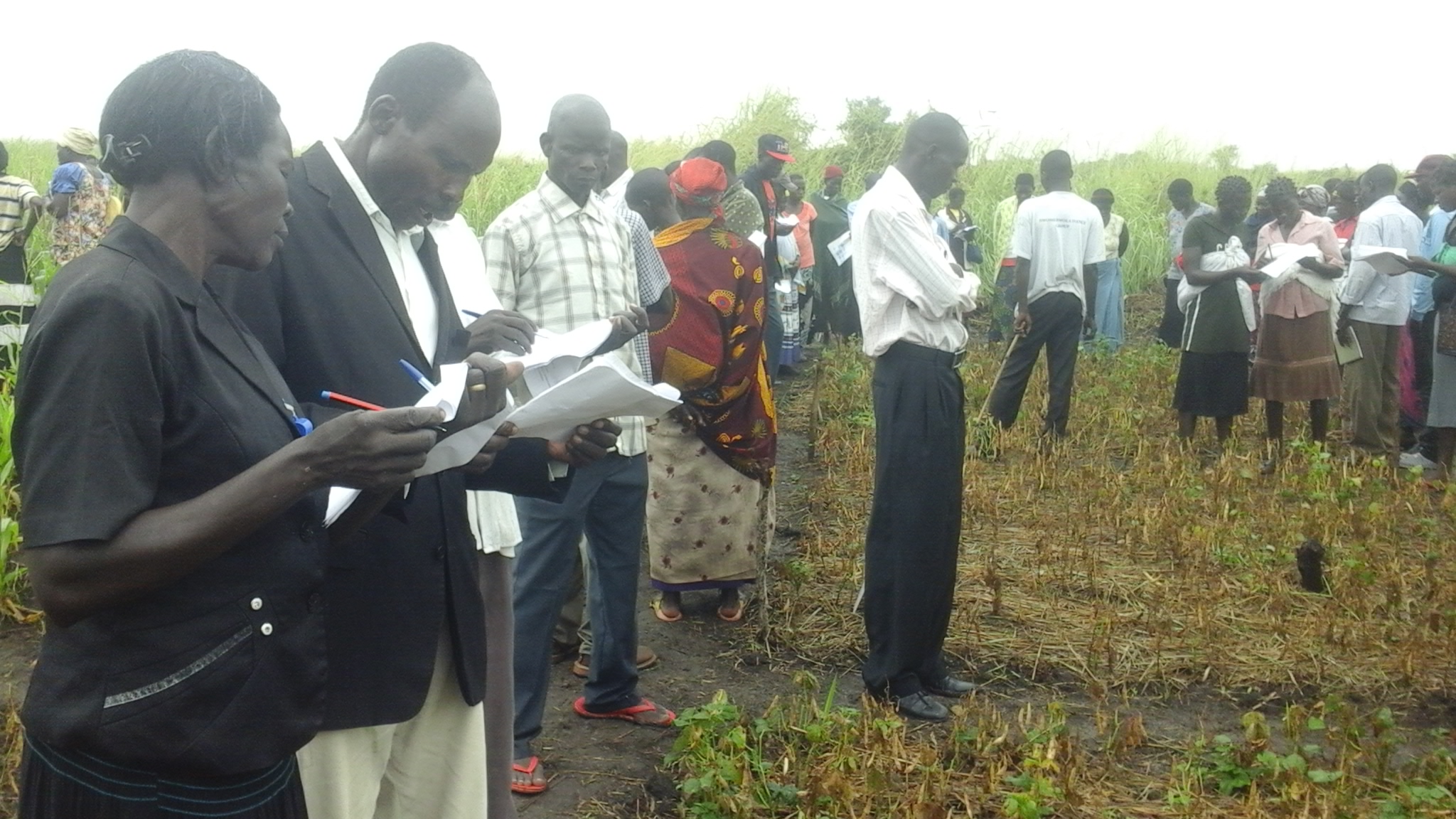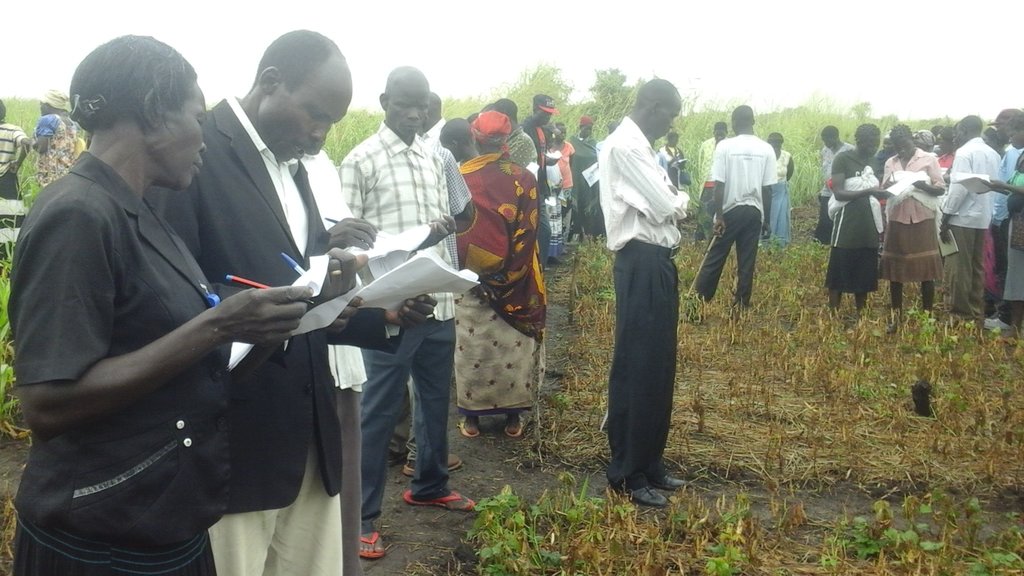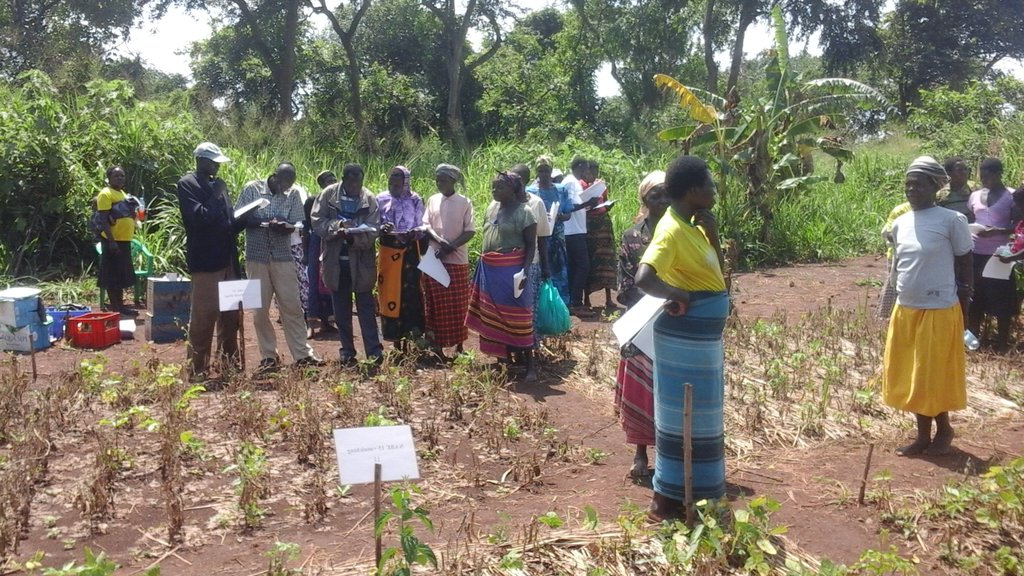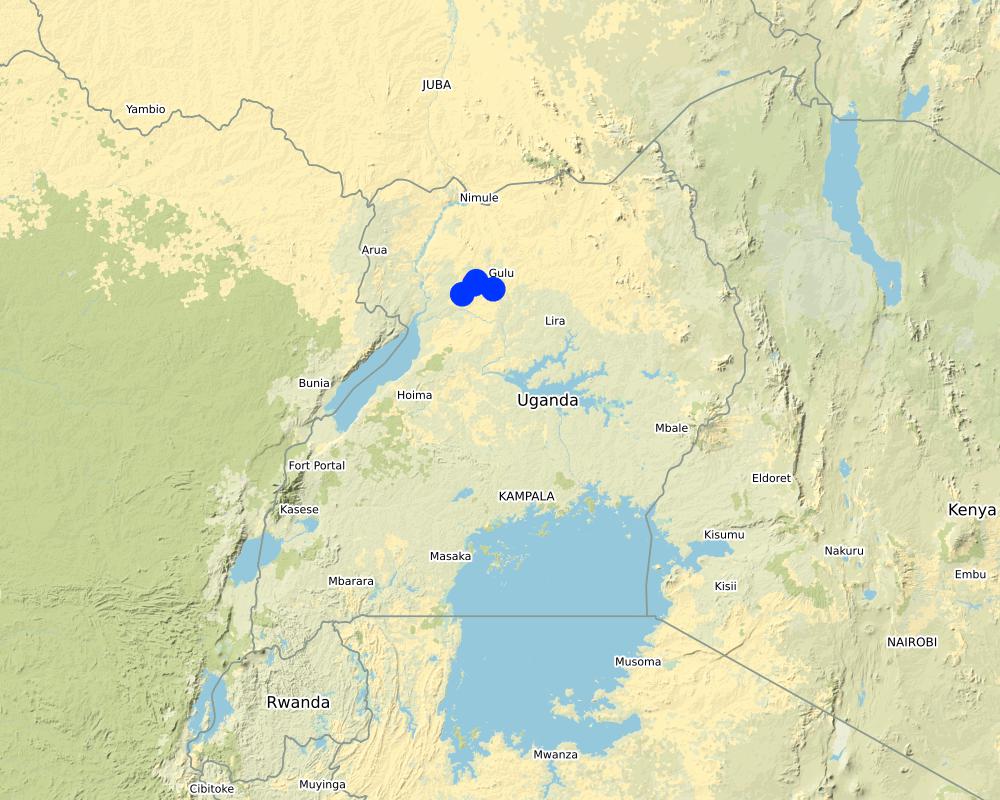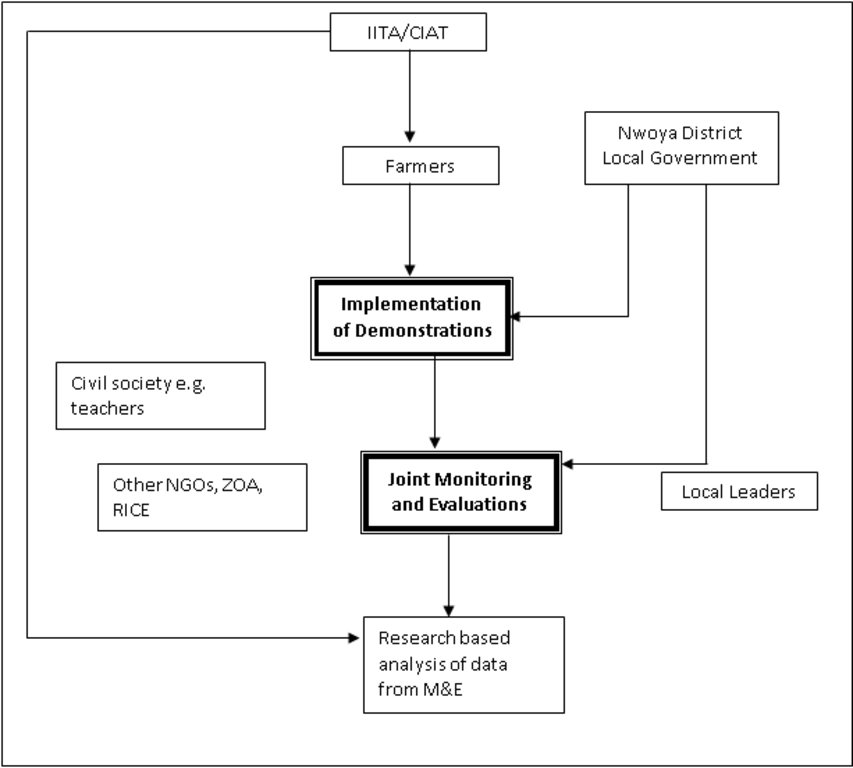Participatory Monitoring and Evaluation of Demonstration Plots [اوغندا]
- تاريخ الإنشاء:
- تحديث:
- جامع المعلومات: Sunday Balla Amale
- المحرر: JOY TUKAHIRWA
- المُراجع: Udo Höggel
Lwak kamoko ber pa diro
approaches_3370 - اوغندا
عرض الأقسام
توسيع الكل طي الكل1. معلومات عامة
1.2 تفاصيل الاتصال بالأشخاص الرئيسيين لمصدر المعلومات والمؤسسات المعنية بتقييم وتوثيق النهج
اسم المشروع الذي سهّل توثيق/تقييم النهج (إذا كان ذلك على صلة)
Scaling-up SLM practices by smallholder farmers (IFAD)اسم المؤسسة (المؤسسات) التي سهلت توثيق/تقييم النهج (إذا كان ذلك على صلة)
Makerere University (Makerere University) - اوغندا1.3 الشروط المتعلقة باستخدام البيانات الموثقة من خلال WOCAT
متى تم تجميع البيانات (ميدانيا)؟:
14/11/2017
يوافق جامع المعلومات والشخص (لاشخاص) الرئيسي لمصدر المعلومات على الشروط المتعلقة باستخدام البيانات الموثقة من خلال WOCAT:
نعم
2. وصف نهج الإدارة المستدامة للأراضي
2.1 وصف موجز للنهج
In Participatory Monitoring and Evaluation of demonstrations, all the players or stakeholders involved in the implementation of the demonstration come together to carry out a joint monitoring and evaluation of the performance of the technology being implemented.
2.2 وصف تفصيلي للنهج
وصف تفصيلي للنهج:
Demonstration plots established to train farmers are common channels through which recommended farming practice(s) are demonstrated to local farmers. During this process, all the relevant stakeholders in the agricultural sector, for example farmers, local leaders and government extension officers, partner organisations, and the lead implementing agency plan together on how best to implement the demonstration with emphasis on the host community, their roles and responsibilities so as to ensure successful implementation of the demonstration.
Stakeholders involved include:
•Group and community members (women, youth and men)
•Local leaders and authorities
•Civil servants
•Partner Non-Governmental Organisations (NGOs)
•Lead implementing agencies (International Institute of Tropical Agriculture, IITA and International Center for Tropical Agriculture, CIAT)
For the subsequent monitoring and evaluation (M&E) process, the participating stakeholders are invited for a field day on the site of the demonstration. Such M&E process is performed twice or three times during implementation of the demonstration activities depending on necessity, availability of time and resources. The M&E tool is designed by the M&E officer in the organization (IITA/CIAT) supported by the Field Officer/Research Assistant who is responsible for carrying out the field activities. The emphasis of the M&E process is on the goals and objectives, sustainability and adaptive nature, socio-economic and political environment, gender and policy considerations and impacts of the project being implemented. Group members help identifying the stakeholders in their community who can be resourceful in evaluating the demonstrations.
The Participatory Monitoring and Evaluation (PM&E) of the demonstration process, activities and performance is then carried out. It aims to:
•Assess the technology/practice(s) in question in terms of crop vigour and yield
•Understand the resilience of the practice to local prevailing climatic and weather conditions
•Assess whether equal opportunity was given for all community members to participate
•Assess the level of cooperation among group members during meetings
•Understand the gender perspectives with regard to gender equality, woman and youth involvement
•Test for the benefits, performance, pros and cons, and the opportunity cost involved in adopting a demonstrated technology
The PM&E questionnaire is based on IITA/CIAT PM&E tool and is composed of the following chapters:
1.Socio-demographic characteristics: district, sub-county, village, name, telephone contact, age, sex, educational level, employment and group-membership of the participant.
2.Farming characteristics: years of farming experience, total amount of land owned and allocated for farming or particular technology of interest, type of seed (local or improved) and the variety of the crop in question, source of seed and whether or not the participant participated in implementing the demonstration.
3.Implementation performance: Demo-plot location, distance, farmer trainings, demo-management, partnerships in the implementation, participation, cooperation, importance, relevance, monitoring of the demo, involvement in terms of community, gender, youth and the vulnerable groups and attendance.
4.Crop performance: Germination percentage, crop vigour, plant height, number of pods/cobs, pod/cob filling, maturity duration, yield, soil quality, pest occurrence, disease and drought resistance/tolerance.
5.Agro-ecological benefits: This can be ranked in terms of importance of the practice for soil fertility and bio-diversity, adaptation to weather variability and climate change.
6.Socio-economic benefits: This is ranked based on importance for household food and nutrition security, source of income, labour demands and cost of implementation.
7.Participants are then required to rank the technologies monitored.
The scale of ranking ranges from 1 to 5, where 1=Very Unhappy, 2=Unhappy, 3=neither Happy nor Unhappy, 4=Happy, 5=Very Happy. For certain questions, emoji illustrations are also used for the monitoring process.
2.3 صور عن النهج
2.5 البلد/المنطقة/المواقع التي تم تطبيق النهج فيها
البلد:
اوغندا
المنطقة/الولاية/المحافظة:
Northern Uganda
مزيد من التفاصيل حول الموقع:
Nwoya District
Map
×2.6 تواريخ بدء وإنهاء تنفيذ النهج
في حالة عدم معرفة السنة بالتحديد، يرجى الإشارة إلى التاريخ التقريبي لبدء النهج:
منذ أقل من 10 سنوات (مؤخرًا)
2.7 نوع النهج
- قائم على مشروع/برنامج
2.8 الغايات/الأهداف الرئيسية للنهج
All stakeholders appreciate their involvement and hence adopt the technology for purposes of learning and knowledge sharing
2.9 الظروف التي تمكن أو تعيق تنفيذ التقنية/التقنيات المطبقة بموجب النهج
المعايير والقيم الاجتماعية /الثقافية/ الدينية
- تمكين/تمكيني
Corperation among all stakeholders
- معيق
Time and resource needed to bring all stakeholders together
توفر/الوصول إلى الموارد والخدمات المالية
- تمكين/تمكيني
This approach enables joint presentation and contribution of projects for funding
الإطار المؤسساتي
- تمكين/تمكيني
Local farmer groups are activated , share knowledge and information
- معيق
Bureaucratic processes in decision making to participate in the process
التعاون/التنسيق بين الجهات الفاعلة
- تمكين/تمكيني
Common interest in sustainable agriculture and support to farmer activities
الإطار القانوني (حيازة الأراضي، وحقوق استخدام الأراضي والمياه)
- تمكين/تمكيني
Presence of rules and regulations that bind the stakeholders to jointly monitor and evaluate as a team
- معيق
Poor and weak implementation and enforcement of rules and regulations
السياسات
- تمكين/تمكيني
Local and national policies on bottom up approach where all stakeholders are involved in decision making, starting from the lowest
حوكمة الأراضي (صنع القرار والتنفيذ والإنفاذ)
- تمكين/تمكيني
People are able to come together to participate in an activity that is related to land management
- معيق
Divergent interests and expectations during monitoring and evaluation
المعرفة حول الإدارة المستدامة للأراضي، والوصول إلى الدعم الفني
- تمكين/تمكيني
Learning about SLM from the process of monitoring and evaluation
الأسواق (لشراء المدخلات وبيع المنتجات) والأسعار
- تمكين/تمكيني
Affordable prices and quality inputs
- معيق
Exploitation by middle men and use of expired inputs on demonstration plots
عبء العمل، توفر القوى العاملة
- تمكين/تمكيني
Shared roles and responsibilities among men and women during monitoring and evaluation
- معيق
Dominance resulting into conflicts over roles and responsibilities
غير ذلك
- تمكين/تمكيني
Presence of monitoring and evaluation committee
- معيق
Understanding roles and responsibilities of the participatory monitoring and evaluation committee
3. المشاركة وأدوار الأطراف المعنية
3.1 أصحاب المصلحة المعنيون بالنهج وأدوارهم
- مستخدمو الأراضي المحليون/المجتمعات المحلية
Farmers
Establish the demonstration, carry out activities in demonstrations, monitor and evaluate the demonstration
- المنظمات المجتمعية
Local CBOs
Partipate in M&E of the demonstration
- الباحثون
International Institute of Tropical Agriculture (IITA), International Center for Tropical Agriculture (CIAT)
Introduced the monitoring / evaluation approach, participate in the monitoring process
- المعلمون / أطفال المدارس / الطلاب
Teachers from local schools
Participate in monitoring / evaluation
- منظمة غير حكومية
Organisation ZOA - from relief to recovery (https://www.zoa-international.com/), other local NGOs
Participate in monitorng / evaluation
- الحكومة المحلية
Subcounty and District officials
Participate in monitorng / evaluation
إذا كان هناك العديد من الأطراف المعنية، قم بالإشارة إلى الوكالة الرائدة:
International Institute of Tropical Agriculture-IITA
3.2 انخراط مستخدمي الأراضي المحليين/المجتمعات المحلية في المراحل المختلفة للنهج
| انخراط مستخدمي الأراضي المحليين/المجتمعات المحلية | حدد من شارك وصف الأنشطة | |
|---|---|---|
| المبادرة/التحفيز | تفاعلي | Farmers and local leaders |
| التخطيط | الدعم الخارجي | Support from IITA |
| التنفيذ | تفاعلي | Farmers, Local leaders, Partner NGOs, IITA |
| الرصد/التقييم | تفاعلي | Farmers, Local leaders, Partner NGOs, Policy makers |
| Publication of output | سلبي | IITA as the organisation implementing the project |
3.3 مخطط التدفق (إذا كان متاحًا)
الوصف:
Flow chart showing process that leads to the implementation of participatory monitoring and evaluation
المؤلف:
Sunday Balla
3.4 اتخاذ القرار بشأن اختيار تقنية/تقنيات الإدارة المستدامة للأراضي
حدد من الذي قرر اختيار التقنية/التقنيات التي سيتم تنفيذها:
- جميع الجهات الفاعلة ذات الصلة، كجزء من نهج تشاركي
حدد على أي أساس تم اتخاذ القرارات:
- تقييم المعرفة الموثقة جيدًا بشأن الإدارة المستدامة للأراضي(اتخاذ القرارات القائمة على الأدلة)
4. الدعم الفني وبناء القدرات وإدارة المعرفة
4.1 بناء القدرات/التدريب
هل تم تقديم التدريب لمستخدمي الأراضي / الأطراف المعنيين الآخرين؟:
نعم
حدد من تم تدريبه:
- مستخدمو الأراضي
- موظفون ميدانيون/ مستشارون
شكل التدريب:
- مناطق العرض
4.2 خدمة استشارية
هل يملك مستخدمو الأراضي وصولا إلى خدمة استشارية؟:
نعم
- Demonstration sites identified by farmers
4.3 تعزيز المؤسسات (التطوير التنظيمي)
هل تم إنشاء أو تعزيز مؤسسات من خلال هذا النهج؟:
- نعم، باعتدال
حدد المستوى (المستويات) التي تم فيها تعزيز أو إنشاء المؤسسات:
- محلي
- إقليمي
- وطني
حدد نوع الدعم:
- بناء القدرات/التدريب
4.4 الرصد والتقييم
هل يشكل الرصد والتقييم جزءا من النهج؟:
نعم
التعليقات:
It is the exact approach
إذا كانت الإجابة بنعم، فهل من المقصود استخدام هذه الوثائق للمراقبة والتقييم؟:
نعم
4.5 البحوث
هل كانت البحوث جزءًا من النهج؟:
نعم
حدد المواضيع:
- علم الايكولوجيا
أعط تفاصيل إضافية وأشر إلى من قام بالبحوث:
IITA-Climate Smart Agriculture Research. Research focused on increasing food security and farming systems' resilience in East Africa
5. التمويل والدعم المادي الخارجي
5.1 الميزانية السنوية لمكون الإدارة المستدامة للأراضي في النهج المذكور
إذا لم تكن الميزانية السنوية الدقيقة معروفة، قم بالإشارة إلى نطاقها:
- 10,0000-2,000
5.2 الدعم المالي/المادي المقدم لمستخدمي الأراضي
هل حصل مستخدمو الأراضي على دعم مالي/ مادي لتنفيذ التقنية/ التقنيات؟:
كلا
5.3 إعانات لمدخلات محددة (بما في ذلك العمالة)
- غير موجود
إذا كان العمل من قبل مستخدمي الأراضي مدخلاً جوهريًا، فهل كان:
- تطوعي
5.4 الائتمان
هل تم توفير ائتمان في إطار نهج أنشطة الإدارة المستدامة للأراضي؟:
كلا
5.5 حوافز أو وسائل أخرى
هل تم استخدام حوافز أو أدوات أخرى لتشجيع تنفيذ تقنيات الإدارة المستدامة للأراضي؟:
نعم
إذا كانت الإجابة بنعم، حدد:
Refreshments during PM&E and demonstration activities eg. water or soft drinks
6. تحليل الأثر والتصريحات الختامية
6.1 آثار النهج
هل ساهم النهج في تمكين مستخدمي الأراضي المحليين وتحسين مشاركة الأطراف المعنية؟:
- لا
- نعم، قليلا
- نعم، باعتدال
- نعم، إلى حد كبير
Local users understand what kind of paramenters can be considered for an evaluation
هل مكّن النهج من اتخاذ القرارات المبنية على الأدلة؟:
- لا
- نعم، قليلا
- نعم، باعتدال
- نعم، إلى حد كبير
The approach enables farmers to take decisions based on what they observed during the evaluation process
هل نجح النهج في تحسين التنسيق والتنفيذ الفعال من حيث التكلفة لأنشطة الإدارة المستدامة للأراضي؟:
- لا
- نعم، قليلا
- نعم، باعتدال
- نعم، إلى حد كبير
All stakeholders took part in the implementation and PM&E process. This improved coordination and resource sharing
هل نجح النهج في تعبئة/تحسين الوصول إلى الموارد المالية لتنفيذ الإدارة المستدامة للأراضي؟:
- لا
- نعم، قليلا
- نعم، باعتدال
- نعم، إلى حد كبير
Stakeholder platform helps to share and identify potential sources of resource and fund mobilisation
هل أدى النهج إلى تحسين معرفة وقدرات مستخدمي الأراضي على تنفيذ الإدارة المستدامة للأراضي؟:
- لا
- نعم، قليلا
- نعم، باعتدال
- نعم، إلى حد كبير
Each participant understood in depth the process involved in implementing a given technology
هل أدى النهج إلى تحسين معرفة وقدرات الأطراف المعنية الأخرى؟:
- لا
- نعم، قليلا
- نعم، باعتدال
- نعم، إلى حد كبير
Participants learned important indicators for demonstrations and how to assess them
هل ساهم النهج في بناء/تعزيز المؤسسات والتعاون بين الأطراف المعنية؟:
- لا
- نعم، قليلا
- نعم، باعتدال
- نعم، إلى حد كبير
Many stakeholders were part of the platform, ranging from local schools and institutions as part of the civil society
هل ساهم النهج في التخفيف من حدة الصراعات؟:
- لا
- نعم، قليلا
- نعم، باعتدال
- نعم، إلى حد كبير
Participants learned how to collaborate in groups
هل ساهم النهج في تمكين الفئات المحرومة اجتماعيا واقتصاديا؟:
- لا
- نعم، قليلا
- نعم، باعتدال
- نعم، إلى حد كبير
All community members were invited to learn and participate hence acquiring knowledge
هل أدى النهج إلى تحسين المساواة بين الجنسين وتمكين النساء والفتيات؟:
- لا
- نعم، قليلا
- نعم، باعتدال
- نعم، إلى حد كبير
The approach involved all age groups and gender with focus on widows
هل شجع النهج الشباب/الجيل القادم من مستخدمي الأراضي على الانخراط في الإدارة المستدامة للأراضي؟:
- لا
- نعم، قليلا
- نعم، باعتدال
- نعم، إلى حد كبير
Youth were at the forefront of implementation
هل أدى النهج إلى تحسن في مسائل حيازة الأراضي / حقوق المستخدمين التي أعاقت تنفيذ تقنيات الإدارة المستدامة للأراضي؟:
- لا
- نعم، قليلا
- نعم، باعتدال
- نعم، إلى حد كبير
Participants learned about the importance of learning and the allocation for various activities. ZOA carried out land and conflict resolutions and helped farmers acquiring land titles from the Government
هل أدى هذا النهج إلى تحسين الأمن الغذائي / تحسين التغذية؟:
- لا
- نعم، قليلا
- نعم، باعتدال
- نعم، إلى حد كبير
Participants identify which technology addresses their food and nutrition security needs
هل أدى النهج إلى تحسين الوصول إلى الأسواق؟:
- لا
- نعم، قليلا
- نعم، باعتدال
- نعم، إلى حد كبير
Farmers identify which technology is a suitable income basing on the available market opportunities
هل أدى النهج إلى تحسين الوصول إلى المياه والصرف الصحي؟:
- لا
- نعم، قليلا
- نعم، باعتدال
- نعم، إلى حد كبير
The approach utilized local community group which also carry out Savings, borehole maintenance and community Village Health teams
هل أدى النهج إلى تحسين قدرة مستخدمي الأراضي على التكيف مع التغيرات المناخية/الظواهر المناخية المتطرفة والتخفيف من الكوارث المرتبطة بالمناخ؟:
- لا
- نعم، قليلا
- نعم، باعتدال
- نعم، إلى حد كبير
Farmers identify technologies, resilient to weather variability and weather extremes
6.2 المحفز الرئيسي لقيام مستخدمي الأراضي بتنفيذ الإدارة المستدامة للأراضي
- زيادة الإنتاج
High yields of crops
- زيادة الربح (القدرة)، وتحسين نسبة التكلفة إلى العائد
Market available for the products from SLM technology
- الحد من تدهور الأراضي
Soil and fertility management
- الحد من مخاطر الكوارث
Reduced risks of drought, pest and disease incidences, floods
6.3 استدامة أنشطة النهج
هل يمكن لمستخدمي الأراضي المحافظة على استدامة ما تم تنفيذه من خلال النهج (بدون دعم خارجي)؟:
- نعم
إذا كانت الإجابة بنعم، صف كيف:
During the PM&E Process, the land users are required to indicate their interest in the adoption of particular technologies and the challenges they would face. Therefore this process enables the farmers to know the requirements for implementing a given technology, pros and cons and how to sustain it economically and environmentally.
6.4 نقاط قوة/مزايا النهج
| نقاط القوة/ المزايا/ الفرص من وجهة نظر مستخدمي الأراضي |
|---|
| It is participatory |
| All stakeholders are involved |
| Individual opinions is considered |
| نقاط القوة/ المزايا/ الفرص من وجهة نظر جامع المعلومات أو غيره من الاشخاص الرئيسيين لمصدر المعلومات |
|---|
| It is a research based approach and quantitative data can be obtained from such an approach |
| Basic sign and labels on the PM&E tool is easy for local farmers to understand |
6.5 نقاط الضعف/ العيوب في المنهج وطرق التغلب عليها
| نقاط الضعف/ المساوىء/ المخاطر من وجهة نظر مستخدم الأراضي | كيف يمكن التغلب عليها؟ |
|---|---|
| The participants may not understand clearly what information is required of them. This can be due to misunderstanding of questions, indicators and possible responses if they are not properly explained. | Eloquent speaker of the local language should act as enumerator to clearly explain what is required of the participants. This can be coupled with emoji illustrations besides the questionnaire. |
| نقاط الضعف/ المساوىء/ المخاطر من وجهة نظر جامع المعلومات أو غيره من الاشخاص الرئيسيين لمصدر المعلومات | كيف يمكن التغلب عليها؟ |
|---|---|
| Simple, visible and easy to understand attributes or parameters are considered. for example plant yield, vigor, participation. Some factors like long term benefits, cost benefit considerations were not included. | Perceptions and Attitudes, Simple cost benefit considerations can be included in the evaluation. |
7. المراجع والروابط
7.1 طرق جمع/مصادر المعلومات
- زيارات ميدانية، مسوحات ميدانية
All stakeholders involved during the field day activity should participate in the PM&E
الروابط والوحدات المواضيعية
توسيع الكل طي الكلالروابط
لا يوجد روابط
الوحدات المواضيعية
لا يوجد وحدات مواضيعية


